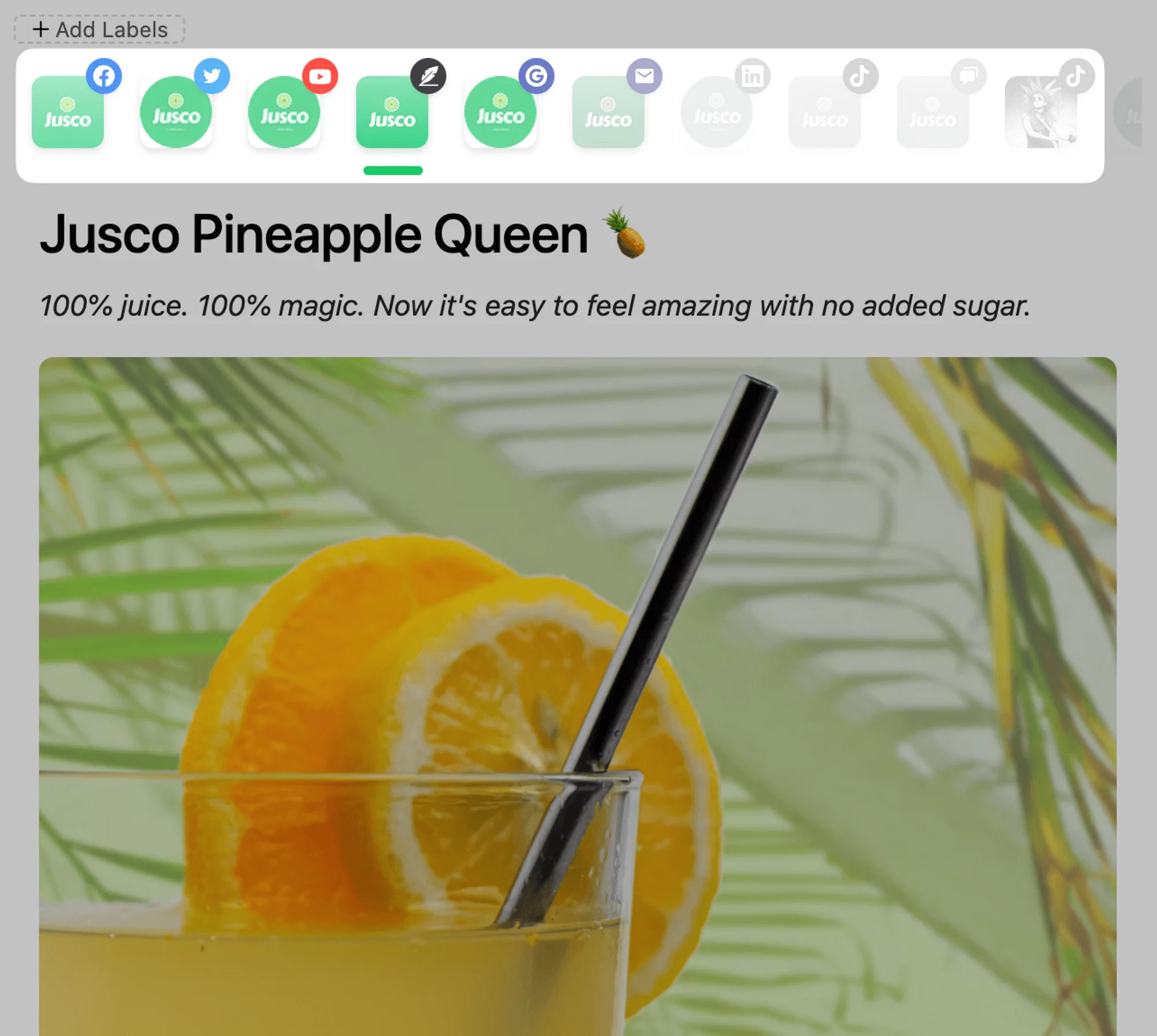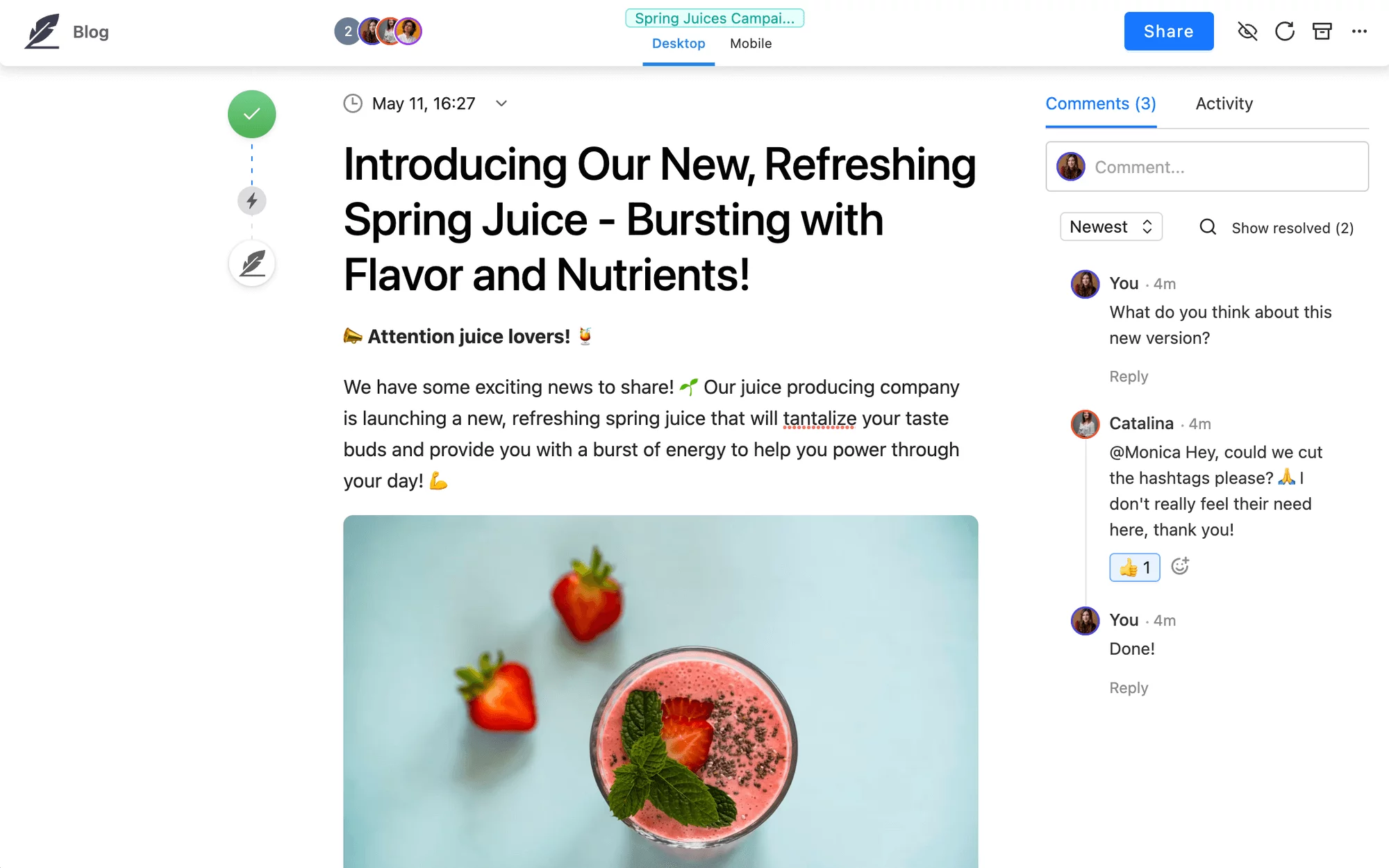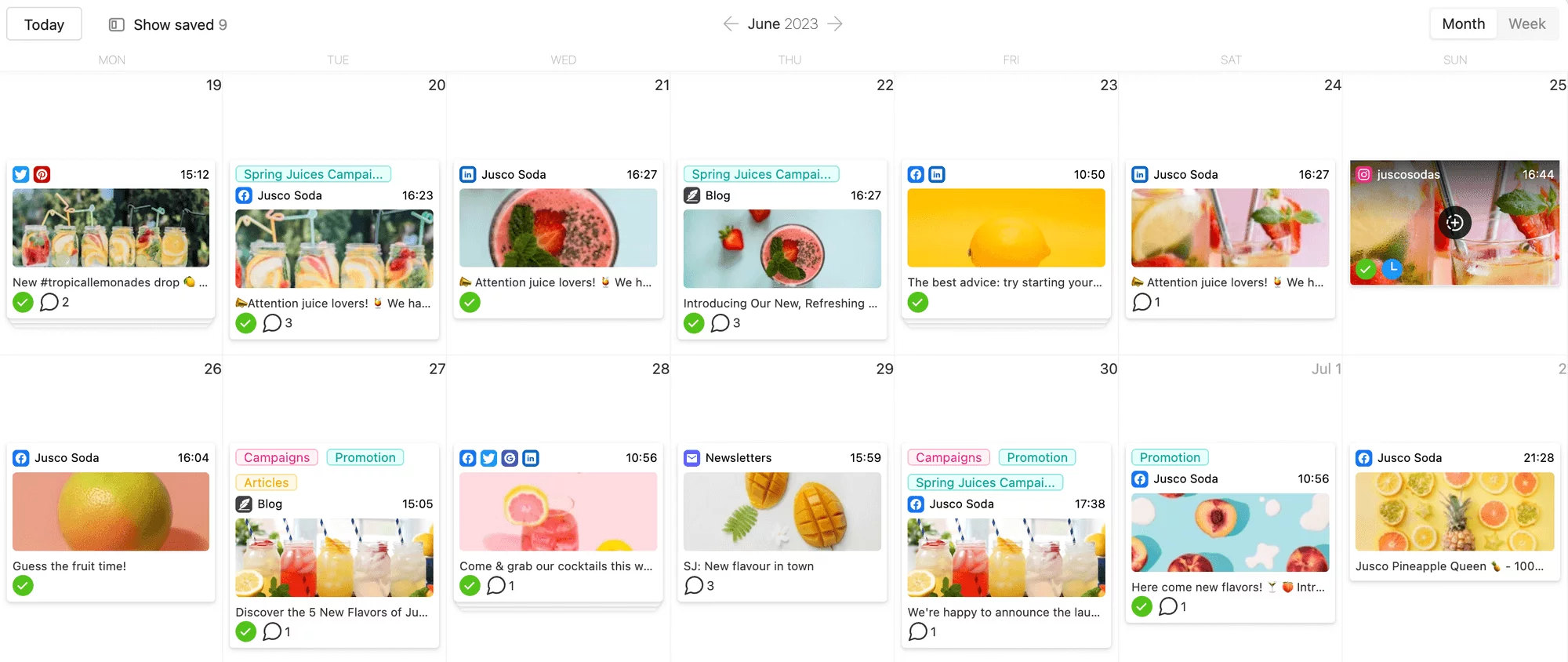Eager to implement impactful and memorable marketing campaigns? Learn how to craft a strategic marketing campaign plan that aligns stakeholders and optimizes channel distribution, ensuring goal achievement.
Without a plan supported by a content calendar, marketing efforts are likely to be scattered and ineffective. Whether working in a team or independently, continue reading for an in-depth, actionable campaign plan template to make ideas shine and leads follow.
Contents
What is a marketing campaign plan?
A marketing campaign plan is a strategic document that outlines the goals, strategies, and tactics for a specific marketing campaign. This blueprint encapsulates the target audience, promotional strategies, and steps to launch, manage a campaign, and measure the campaign’s success.
The campaign framework is essential for businesses of all sizes as a roadmap for coordinating efforts, optimizing resources, and maximizing campaign impact.
Why you should plan out your marketing campaign
You can throw darts in the dark, hoping to hit some target. Or you can turn the lights on and see what you’re aiming at, if you’re any good at it, and learn to course correct.
Creating a marketing campaign plan is just like turning on the lights. It helps align promotional efforts to business goals, improves efficiency, and makes the game fun.
Clear direction for all stakeholders involved
While the marketing team is the primary driver for a marketing campaign, it can involve different layers of the organization, from the executive team to sales and product managers.
With a clear plan, it’s easy to communicate the marketing strategy internally and externally. Everyone knows the goals, to what extent they are involved, what steps they need to take, and how to evaluate success.
Creative input from team members
People given a chance to contribute and get involved in a plan early, from the campaign concept, are more likely to be motivated to execute it efficiently and come up with brilliant creative assets.
The planning process gives everyone a chance to provide ideas and creative input. It puts team members on the same page and ensures the marketing campaign starts on the right foot.
Better distribution of campaign assets
A well-structured marketing campaign plan facilitates smoother collaboration, prevents unnecessary content creation, and maintains a unified brand presence, especially if you have an approval process.
With a coherent marketing plan, campaign assets like visuals, messaging, and design elements can be strategically repurposed across various content distribution channels, ensuring consistency and maximizing efficiency.
5 steps to a complete a marketing campaign plan
Ready to map out your next successful marketing campaign?
Below are the five most important steps to cover in the planning process, with suggestions, tools, and examples to help you streamline your efforts. Use these steps as a marketing campaign template.
1. Set your campaign goals and budget
The first step in creating your marketing strategy is defining goals.
What do you want to achieve? Are you looking to create brand awareness, generate leads, or drive sales?
Be specific. Trying to hit too many targets simultaneously can result in diluted messages and marketing efforts being spread thin.
Here are some examples of campaign goals that are clear, actionable, and measurable:
- Increase website traffic by 30%
- Generate 50 new leads per month
- Increase engagement by 15%
- Promote an event to get 250 participants
Your campaign success depends on how well you define goals because those put everything else in motion.
Agree on your key performance indicators
You can use many key performance indicators to measure the success of marketing campaigns. Your KPIs must be aligned with specific business goals.
Here are some common marketing metrics to address through your KPIs:
- Return on investment (ROI) measures the money you make from marketing campaigns.
- Cost per acquisition (CPA) measures your spending on getting a new customer.
- Cost per lead (CPL) measures how much you spend to generate a new lead.
- The conversion rate measures the percentage of people who click on a call to action, sign up for an event, subscribe to a newsletter, or buy a product.
- Website traffic measures how many people visit your website.
- Social media engagement measures the level of interaction your content gets, such as likes, shares, and comments.
- Customer satisfaction measures how happy clients are with your products or services.
To measure these KIPs, use analytics tools, surveys, or customer feedback tools. Track KPIs consistently and only focus on those relevant to your campaign.
Ensure your entire team is on board with the goals and aware of which metrics determine the campaign’s success.
Establish your campaign budget
Once you know your goals, you can start thinking about how much money you need to spend.
Typically, your marketing campaign will need a budget for the following:
- Creative assets can be produced in-house or with collaborators, such as freelancers or agencies. These can be blog posts, videos, ebooks, etc. Depending on the type of asset, you will need:
- Copywriting
- Graphic design
- Video production
- Advertising, including digital ads, print media, outdoor ads, and more. In addition to standard digital advertising tools, there are many advanced solutions with more diverse and flexible ad formats and targeting options. For example, Epom, an adtech provider that has a wide range of innovative advertising technologies, both programmatic and ad serving.
- Social media marketing can be done by the in-house team or externalized. Use a robust social media management tool to streamline team collaboration and automate tasks.
- Public relations, including press releases, media outreach, and maintaining a positive brand image. Having a PR calendar enhances overall coordination.
- Influencer marketing to promote your products or services with the help of well-known content creators.
- Technology and tools include marketing automation software, analytics tools, content distribution tools, etc.
- Search Engine Optimization (SEO) means investing in research and tools to optimize your website or landing pages for better search engine rankings.
- Enacting privacy laws because laws like the GDPR (EU) and CCPA (California) require you to have a privacy policy and to allow users to opt in (GDPR) or opt out (CCPA) of personal data collection. You can look into using a marketing privacy policy template or hire a lawyer to create a privacy policy.
Be realistic when planning your marketing campaign budget. You need enough money to reach your target audience on the proper communication channels to achieve your goals. But also be careful to spend wisely, or your ROI will not be satisfactory.
2. Be clear on your target audience
You must reach the people in your target market interested in your offering. Look at current customers to understand what is already working, find insights in analytic tools, and search for industry research for data and trends. You can use tools for customer support or a cloud contact center to keep the gathered data centralized.
Define your campaign audience using the following main categories:
- Demographics: age, gender, location, income, and education level.
- Psychographics: interests, hobbies, and values.
- Behavioral: purchase history, online activity, behaviors in past marketing campaigns, etc.
Understand the pain points of your potential customers, establish a relevant key message, and identify preferred communication channels.
Your business can have a broad target audience, but each marketing campaign will probably have a narrow one, depending on the campaign strategy. Moreover, different groups will respond better to tailored messages within each campaign. Use audience segmentation to connect with people more personally and drive higher engagement through personalization.
Decide the best channels to reach your audience
How do you choose the proper marketing channels for your marketing campaigns? Here are some tips and a few questions to ask:
- Look at where your existing customers spend their time. What channels do they use? How much time do they spend there, and when will they most likely engage?
- Evaluate how much each channel costs and decide if it is valuable enough. A multi-channel campaign effectively reaches more people and conveys your message, but you must also consider your budget and other resources.
- Track results to see the most effective channels and optimize your marketing activities.
- Analyze competitors’ marketing activities. Find out which channels work best for them but also where they are not that present. Is there an opportunity to reach customers there?
Here are the distribution channels to consider for your next marketing campaign:
- Digital marketing channels, such as:
- Social media marketing on Facebook, Instagram, Twitter/X, LinkedIn, TikTok, or Pinterest.
- Search engine marketing (SEM)
- Email marketing
- Affiliate marketing
- Influencer marketing
- Offline marketing: print advertising, television advertising, and direct mail.
- Word-of-mouth: recommendations from friends and family and online reviews on social media channels, Google My Business reviews, or other review websites.
- WhatsApp Chatbot: automated responses, lead qualification, personalized customer support, campaign distribution, follow-ups and reminders, and interactive features.
There are many options to choose from when you create a marketing campaign. Don’t worry. Your marketing plan doesn’t have to be perfect, just good enough. Start with the most relevant channels for your audience, test and finetune your content, and add more channels in time if the budget allows it. You can also check out some important email automation tools that can help to build your marketing campaigns.
Also, use a content collaboration and distribution tool such as Planable to make your life easier and juggle content marketing activities effectively.

Marketing channels selection in Planable
3. Brainstorm campaign concepts
Successful campaigns need a catchy, memorable idea, which starts off by implementing a project plan. But coming up with the campaign theme is something other than a daydreaming, divine inspiration type of thing, as some may imagine.
Here’s a process for coming up with that great marketing campaign idea:
- Bring your team together in one or more brainstorming sessions.
- Include colleagues from various departments: marketing, design, sales, and customer service. Different perspectives lead to more dynamic ideas.
- Ensure everyone knows the marketing strategy, goals, and audience details beforehand.
- Look at other marketing campaign examples for inspiration. Discuss what worked and why.
- Allow the conversation to flow naturally. Encourage even the wildest marketing campaign ideas. You won’t implement all, but they nurture the creative process.
After brainstorming with the extended team, take the list of ideas and go through them again with the marketing team:
- Which idea is more fit for the campaign audience?
- Which is more likely to achieve the proposed goals?
- Which is the one most likely to start conversations?
Choose which creative assets are needed
Depending on your marketing campaign objectives, creative idea, audience, and distribution channels, make a list of types of assets needed.
Images
Graphics are a must in any marketing campaign. Images are a great way to capture attention and communicate your message visually. They can be used in various marketing materials, such as banners, social media posts, ads, blog posts, or media kits.
Video
Video rules the 2023 marketing game. It’s powerful for explaining products or services and engaging viewers. Short videos work great on social media, while longer videos are more appropriate for your website or platforms like YouTube.
Text
Written content is still an essential part of marketing, even nowadays, when there is more focus on visual content. A blog post or ebook can help educate your audience and tell a compelling story.
Audio
There’s nothing quite as immersive as hearing someone’s voice in your ears while doing chores. Podcasts can be an excellent, engaging format for specific audiences.
After deciding which specific creative assets you need, think of resource allocation. Can you handle everything in-house? Do you need help from freelancers or other external teams? Look at everyone’s availability and at the marketing campaign timeline to decide whether you need to bring in more resources.
4. Detail your distribution strategy
Your new campaign is taking shape. It’s time to work on the distribution strategy next.
There are three types of media channels:
- Owned media includes your website, social media accounts, blog, landing pages, newsletters, etc.
- Earned media includes shares and mentions, guest articles, media coverage, reviews, etc.
- Paid media includes social media ads, influencer marketing, sponsored content, SEM, and PPC ads.
Any marketing campaign will use a mix of the above, but not all.
For example, when launching a new product, you must get media coverage through PR efforts and gain awareness and credibility by working with influencers in your industry.
To increase sales, you can nurture existing customers through compelling newsletters and bring in new ones through paid media.
As with everything else, your marketing campaign objective is the guiding light for all decisions.
Create a shared campaign calendar
Streamlining marketing campaign activities and ensuring everyone is on track with content creation and publishing is essential to success. After the initial planning, it’s easy to get delayed by feedback loops, lack of coordination, and limited visibility into progress.
A shared campaign calendar with mapped-out assets and activities can help everyone stay on track. You don’t need to create that from scratch. Luckily, some tools make marketing planning quick.
For example, Planable lets teams collaborate in real-time on all types of content, including briefs, social media posts, blog posts, or newsletters. You can plan, add comments, get feedback, and share with external collaborators.

Collaboration over blog post in Planable
When the content is approved, add it to the content calendar for a complete picture of the entire campaign. The calendar view is helpful in quickly seeing what has been published, what is scheduled, and what still needs finishing.

Marketing content calendar in Planable
Moreover, the color-coded labels let you highlight specific activities or different campaigns, so you can work and collaborate on multiple projects without feeling overwhelmed.
5. Start to execute your marketing campaign
Ready, steady, go! Set a precise launch date for your campaign. Coordinate efforts to ensure all elements are approved to go live simultaneously across different channels.
Plan how you will engage with your audience once the campaign is live. Monitor comments, messages, and interactions across platforms to foster engagement.
Monitor your KPIs as your campaign runs
Monitor campaign metrics and gather data. Use A/B testing to refine headlines, visuals, and calls to action to improve results.
Be open and prepared to adjust your campaign strategy based on real-time insights and feedback.
Don’t forget to update your team and stakeholders on the campaign’s progress. Highlight successes, challenges, and any adjustments made.
Once the marketing campaign concludes, analyze the results against your KPIs. Identify what worked well and what could be improved for future campaigns.
Marketing campaign plan template
Here’s a real-life marketing campaign plan template from the Planable team. Ready for you to copy-paste and start building your next successful marketing campaign.
After many iterations, I created this marketing campaign template that we always start any campaign with. It helps the team get clarity and keeps everything aligned. Now everyone starts with the context, the whys, and the main concept. Our creation and distribution efforts are in sync, our messaging is consistent, and our results are much better.
Miruna Dragomir, CMO at Planable
Wrap up
The steps above work as a plan template to ensure you take all the essential steps to create a great marketing campaign every time. And don’t go at it alone. Register for free with Planable to save time on marketing tactics and focus on those wonderful ideas on your to-do list.




